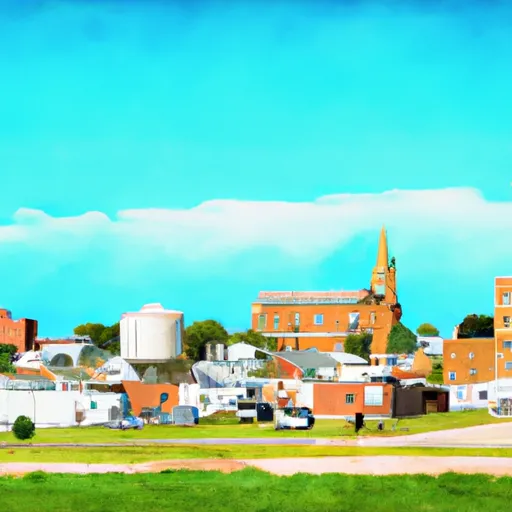-
 Snoflo Premium
Snoflo Premium
Get unlimited access to all our content
With no Ad interruptions! - Start Your Free Trial Login with existing account
Smithfield
Eden Index
Climate
9.2
•
Recreation
2.8
•
Community
•
Safeguard
4.7/10

Smithfield, Nebraska is a small, picturesque town located in the heart of the Midwest. Known for its pleasant climate and abundant outdoor recreation opportunities, Smithfield offers a unique experience for nature enthusiasts. The town experiences a typical Midwestern climate, characterized by warm summers and cold winters. Summers are mild with temperatures ranging from 70 to 85 degrees Fahrenheit, while winters can be quite cold with temperatures dropping below freezing.
Smithfield is blessed with a diverse hydrology. The town is situated near the scenic Smithfield River, which offers excellent fishing and kayaking opportunities. The river is home to various species of fish, including trout and bass, making it a favorite spot for anglers.
Outdoor recreation is a primary focus in Smithfield, with numerous opportunities available. The town boasts well-maintained hiking and biking trails that wind through the beautiful countryside, providing breathtaking views of the surrounding landscapes. Additionally, Smithfield has several parks and picnic areas, perfect for family outings and gatherings. The nearby Smithfield National Forest offers camping and hunting facilities for outdoor enthusiasts.
In conclusion, Smithfield, Nebraska provides an ideal setting for those seeking a pleasant climate, diverse hydrology, and a wide range of outdoor recreation opportunities. Whether it is fishing, hiking, or simply enjoying the natural beauty, Smithfield is a destination that caters to nature lovers of all kinds.
What is the Eden Index?
The Snoflo Eden Index serves as a comprehensive rating system for regions, evaluating their desirability through a holistic assessment of climate health, outdoor recreation opportunities, and natural disaster risk, acknowledging the profound impact of these factors on livability and well-being.
Climate Health Indicator (CHI): 9.2
Smithfield receives approximately
601mm of rain per year,
with humidity levels near 68%
and air temperatures averaging around
10°C.
Smithfield has a plant hardyness factor of
5, meaning
plants and agriculture in this region thrive during a short period during spring and early summer. Most
plants will die off during the colder winter months.
By considering the ideal temperature range, reliable water supplies, clean air, and stable seasonal rain or snowpacks, the Climate Health Indicator (CHI) underscores the significance of a healthy climate as the foundation for quality living.
A healthy climate is paramount for ensuring a high quality of life and livability in a region, fostering both physical well-being and environmental harmony. This can be characterized by ideal temperatures, reliable access to water supplies, clean air, and consistent seasonal rain or snowpacks.
Weather Forecast
Streamflow Conditions
Middle Platte
Area Rivers
Middle Platte
Snowpack Depths
Middle Platte
Reservoir Storage Capacity
Middle Platte
Groundwater Levels
Recreational Opportunity Index (ROI): 2.8
The Recreational Opportunity Index (ROI) recognizes the value of outdoor recreational options, such as parks, hiking trails, camping sites, and fishing spots, while acknowledging that climate plays a pivotal role in ensuring the comfort and consistency of these experiences.
Access to outdoor recreational opportunities, encompassing activities such as parks, hiking, camping, and fishing, is crucial for overall well-being, and the climate plays a pivotal role in enabling and enhancing these experiences, ensuring that individuals can engage in nature-based activities comfortably and consistently.
Camping Areas
| Campground | Campsites | Reservations | Toilets | Showers | Elevation |
|---|---|---|---|---|---|
| Pressey State Wildlife Area | None | 2,429 ft | |||
| George Mitchell RV Park | 10 | 2,058 ft | |||
| Prairie Dog State Park | 190 | 2,347 ft | |||
| Tomahawk Municipal Park | None | 2,485 ft | |||
| Lexington City Park | None | 2,394 ft | |||
| West Side Park - Beaver City | 4 | 2,175 ft | |||
| Morgan Municipal Park | 30 | 2,547 ft | |||
| Victoria Springs State Rec Area | 80 | 2,525 ft | |||
| Logan Lake City Park | None | 2,050 ft |
Catastrophe Safeguard Index (CSI):
The Catastrophe Safeguard Index (CSI) recognizes that natural disaster risk, encompassing floods, fires, hurricanes, and tornadoes, can drastically affect safety and the overall appeal of an area.
The level of natural disaster risk in a region significantly affects safety and the overall livability, with climate change amplifying these risks by potentially increasing the frequency and intensity of events like floods, fires, hurricanes, and tornadoes, thereby posing substantial challenges to community resilience and well-being.
Community Resilience Indicator (CRI):
The Community Resilience Indicator (CRI) recognizes that education, healthcare, and socioeconomics are crucial to the well-being of a region. The CRI acknowledges the profound impact of these elements on residents' overall quality of life. By evaluating educational resources, healthcare accessibility, and economic inclusivity, the index captures the essential aspects that contribute to a thriving community, fostering resident satisfaction, equity, and social cohesion.

